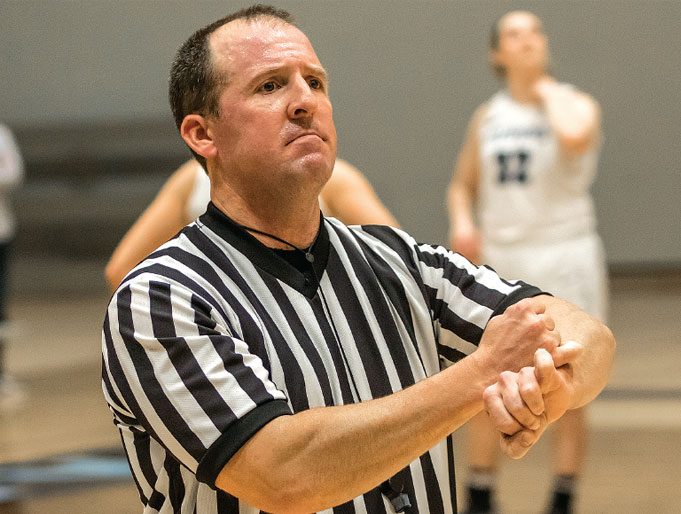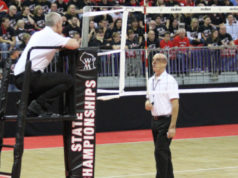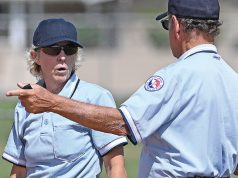In the local football chapter where I started officiating years ago, it has been the practice to have separate weekly training sessions for first-year officials. The feeling is that people new to officiating need to go through the rulebook in A-B-C fashion and that is best done in their own group with veteran officials serving as trainer. Chapter meetings and “newbie” training were on Monday nights, and then veterans and first year officials worked together in sub-varsity games played on Tuesday through Thursday.
The older officials used to joke that we could always tell what rule was the focal point of the first-year meeting that week because, across the board, there would be a sea of flags involving it in the sub-varsity games.
Once, offensive formations were the topic du jour. That Thursday I worked a frosh-JV doubleheader with two first-year guys on the wings. From the start they threw flag after flag for illegal formations. Midway in the second quarter we were nearing the farce stage, so during a timeout I told them not to call another formation foul.
The message they heard on Monday night — not the one intended — was that formation fouls need to be called in spades. In other weeks the same thing happened when holding, pass interference and the like were stressed. A lot of first year officials are afraid to throw their flags even when a real foul occurs, so the result was that often they called virtually nothing the entire day other than what was talked about that Monday.
Those guys couldn’t be faulted because they were new to officiating and didn’t get what the trainers were trying to tell them. I’ve seen other cases, however, where the officials knew the message but figured if they called a lot of fouls involving a rule that had been emphasized at an association meeting, they would earn points. Ironically, when appeasement officiating occurs, leadership comes down harder on them for calling a lot of nitpicky stuff.
I was a collegiate baseball coordinator in the 1990s. Around 1992, I was part of the process that resulted in the adoption of the NCAA collision rule, which is designed to keep runners from crashing into fielders. For purposes of education we made the new rule a focal point in our clinics. But afterward we heard of umpires enforcing it even when the catcher did not have clear possession of the ball.
I’m sure that some who were overly aggressive in enforcement honestly didn’t get that I wasn’t implying that anything other than clear infractions should be called. I fault myself for not being sufficiently cognizant of the fact that my audience consisted of umpires all over the spectrum in skill level and background and making my intent in focusing on the rule clearer and stressing advantage-disadvantage. But I also think that some umpires called infractions not within the spirit of the rule just to prove that they were at the clinic and heard my spiel.
Supervisors and trainers need to clarify their intent when they focus on rules. Are they just trying to educate folks on the meaning? Do they, in fact, want tighter enforcement because they believe that obvious fouls are being ignored? Do they believe that officials need to loosen up a bit? In many, if not most, cases their intent should be obvious, but it’s better to make it clear than to let people guess and, possibly, draw the wrong inference. One cannot assume that the audience will always get the true import of what is intended.
So, when they highlight a rule, leaders should add a caveat: “We’ve been too lax in this area, and we need to step it up because we’re ignoring obvious stuff.” “We’ve gotten too picky here and we need to back off.”
For our part, officials probably need to do a better job, in some instances anyway, of carefully listening to, and drawing reasonable inferences from, what management is saying. If we truly don’t know what the message is, we need to ask. Once we understand, we need to keep uppermost in our minds the fact that we can’t afford to go further than to call the fouls that put one team at an unfair disadvantage. We can’t make a bunch of calls just because we think it will pacify management.
Professional and college officials have had years of advantage disadvantage drilled into them, so they automatically implement that philosophy when they hear a rule being stressed at a meeting or in a memo. Second, every move on the field, and every call, is graded, so they know they can’t afford to take an appeasement approach or their evaluations will suffer.
Supervisors must clarify whether they are educating or trying to get everyone to be more aggressive in enforcing the rule. Officials have the obligation to officiate with the call-what-matters philosophy in mind. We can be forgiven a good faith misunderstanding of what a supervisor wants. Once the message is clear, however, we do everyone a disservice if we start calling a bunch of what may be phantom fouls just because we think it will impress management.
What's Your Call? Leave a Comment:
Note: This article is archival in nature. Rules, interpretations, mechanics, philosophies and other information may or may not be correct for the current year.
This article is the copyright of ©Referee Enterprises, Inc., and may not be republished in whole or in part online, in print or in any capacity without expressed written permission from Referee. The article is made available for educational use by individuals.


















